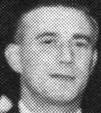|

 Tottenham Court Road is considered a suitable long
term option for Barclays, who operate the branch from the 1969 merger until
the end of 1990. Nowadays it has gone the way of many other former bank
branches in being the ideal site for a pub.
Martins Bank Magazine pays the branch a visit in 1956, when it is less
than a year old, and is keen to point out just how much admiration the
building excites amongst the locals… Tottenham Court Road is considered a suitable long
term option for Barclays, who operate the branch from the 1969 merger until
the end of 1990. Nowadays it has gone the way of many other former bank
branches in being the ideal site for a pub.
Martins Bank Magazine pays the branch a visit in 1956, when it is less
than a year old, and is keen to point out just how much admiration the
building excites amongst the locals…

‘Ordinary Folk’- away from the gangs and vice of Soho…

 Less than ten minutes' walk away from
Garrick Street lies our new branch at Tottenham Court Road, but a whole world
away in atmosphere and setting. Here we are between the stately squares which
contain London University and the British Museum, and the colourful
quarter of Soho. On the one hand you
are in Bloomsbury, haunt of students and tourists, with its many hotels of popular
price mingling with the atmosphere of learning, and on the other hand you are
among the theatrical folk, or in the quarter of fashionable foreign
restaurants, with just that suggestion of background shadow —gangs and haunts of vice—to heighten the interest when one walks
through its well-known streets. But it is all very respectable for ordinary
folk, whether by day or night. Less than ten minutes' walk away from
Garrick Street lies our new branch at Tottenham Court Road, but a whole world
away in atmosphere and setting. Here we are between the stately squares which
contain London University and the British Museum, and the colourful
quarter of Soho. On the one hand you
are in Bloomsbury, haunt of students and tourists, with its many hotels of popular
price mingling with the atmosphere of learning, and on the other hand you are
among the theatrical folk, or in the quarter of fashionable foreign
restaurants, with just that suggestion of background shadow —gangs and haunts of vice—to heighten the interest when one walks
through its well-known streets. But it is all very respectable for ordinary
folk, whether by day or night.

|

|

|
|
Images © Martins Bank Archive Collections
|

 Our
branch occupies an excellent corner site and excites much admiration, both on
account of the attractive and distinctive grained green granite stonework and
the handsome coat-of-arms, designed by Robin and Christopher Ironside, which
surmounts the entrance. Inside, the eye is instantly drawn to the magnificent tapestry which
hangs on the wall of the customers' space facing the entrance. The design
depicts certain prominent landmarks in the Bloomsbury area, and Sax Shaw, the
designer, has created a real work of art.
The architects, Bridgwater and Shepheard, have made of the interior a
general ensemble which is a model for bank buildings of this type. The wooden
panelling in mottled English oak veneer, the
manager's desk built of walnut and made as a permanent fixture, the tasteful
lighting, and not least the pictures on the walls, give an impression of
restful good taste without undue ostentation which is instantly pleasing. The
pictures, both in water colour, depict respectively Lord's Cricket Ground and
a river steamer passing the Tower of London. Our
branch occupies an excellent corner site and excites much admiration, both on
account of the attractive and distinctive grained green granite stonework and
the handsome coat-of-arms, designed by Robin and Christopher Ironside, which
surmounts the entrance. Inside, the eye is instantly drawn to the magnificent tapestry which
hangs on the wall of the customers' space facing the entrance. The design
depicts certain prominent landmarks in the Bloomsbury area, and Sax Shaw, the
designer, has created a real work of art.
The architects, Bridgwater and Shepheard, have made of the interior a
general ensemble which is a model for bank buildings of this type. The wooden
panelling in mottled English oak veneer, the
manager's desk built of walnut and made as a permanent fixture, the tasteful
lighting, and not least the pictures on the walls, give an impression of
restful good taste without undue ostentation which is instantly pleasing. The
pictures, both in water colour, depict respectively Lord's Cricket Ground and
a river steamer passing the Tower of London.

The artist is Edwin la
Dell. The floor of the banking hall is in Belgian fossil and Mazano marble
and the columns are faced with Ashburton marble. The counter top and the
desks are in Australian black bean, and the counter front is in walnut with a
strip of Macassar ebony under the counter top. Mr. E. J. A. Salmon is the
Manager and this is his first experience of a small branch. From 1928 until
1951 he was at 68 Lombard Street in various departments and in various
capacities. He then became a signing officer. In 1954 he was appointed
Assistant Manager at Fenchurch Street and he opened the new branch the
following year. Mr. S. G. C. Hall, his second-in-command, has moved about the
London District quite a bit and has been at 68 Lombard Street, Sloane Square,
Southall, Oxford Circus and on District Office relief. Mr. J. L. Pearson
entered the Bank at Reading, serving there until last year when he went on
District Office Relief for six months until going to Tottenham Court Road. The
lady in our photograph, Miss J. Holbourn, is no longer in the Bank and her
place has been taken by Miss J. S. Scott.
We
concluded our visit by entertaining Mr. and Mrs. Salmon to lunch at a
pre-selected haunt and proved to our satisfaction that in this district by no
means all the best places are in Soho.

|
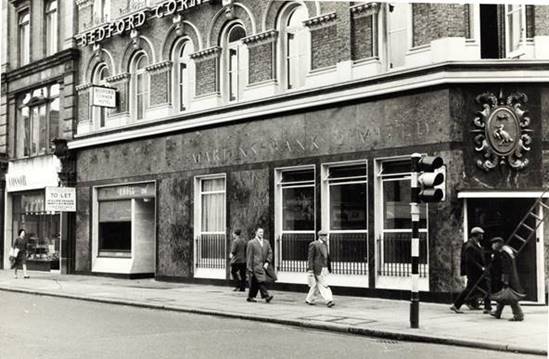
|
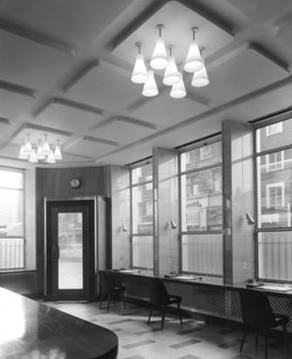
|
|

Images © Barclays Ref
0030-2958

|
|
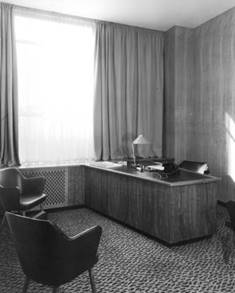
|
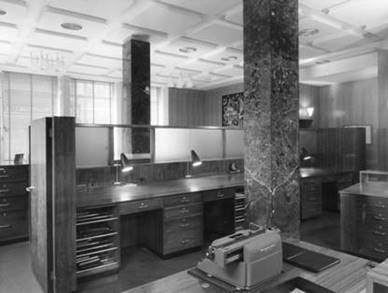
|
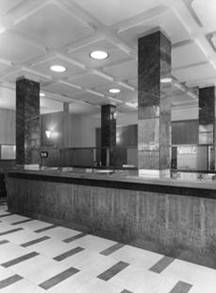
|
|
|
|
|
…Some views in front of, and
behind the scenes: A sense of space, plush furnishings, and Marbled
pillars…
|

Architecture in the News…
|
|
Martins
Bank’s new Branch at Tottenham Court Road joins a growing number of the
banks newest office to be given a lavish spread in the Architect and
Building News Magazine. As well as
featuring a variety of interior and exterior photographs, the article gives
the background to the fitting out of the former Bedford Corner Hotel, and
lists in detail the names of the main contractor and the many sub-contractors
and the materials they provided and fitted. The main text of the Tottenham
Court Road article is reproduced below…
|
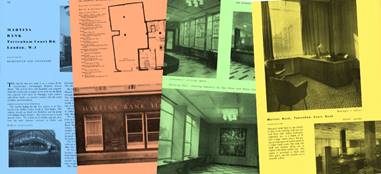

|
|

 The site for this new bank is on a corner of the reconstructed
war-damaged Bedford Corner Hotel. The ground floor and basement was
acquired from the owners and occupier of the hotel by the Bank who required
work space for Manager, three cashiers and eleven clerks; an enquiry
counter and the usual ancillary accommodation. The site for this new bank is on a corner of the reconstructed
war-damaged Bedford Corner Hotel. The ground floor and basement was
acquired from the owners and occupier of the hotel by the Bank who required
work space for Manager, three cashiers and eleven clerks; an enquiry
counter and the usual ancillary accommodation.

CONSTRUCTION AND FINISHES
The marble facing for the two facades is in Tipo issorie
with slightly darker bands in Vert Stella. The window reveals are lined
with Botticino and the plinth with Belgian Black Granite. The windows are
in metal painted white. The grilles are in bronze, and the arms over the
main entrance, designed by Robin and Christopher Ironside, are in bronze
and silver bronze.
|

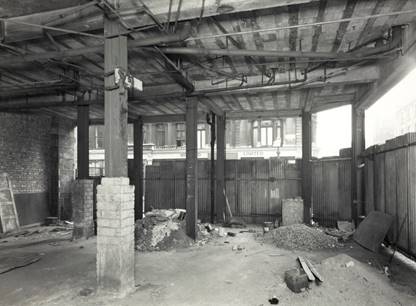
A Glimpse of the Midland Bank during
building preparations
Image © Barclays Ref
0030-2958

|
|
The entrance door and lobby are in teak. The floor of the
banking hall is in Belgian Fossil and Mazano marble, with a Belgian Fossil
marble skirting throughout, and Botticino lining the window reveals.The
columns are faced with Ashburton marble with satin chrome collars at top
and bottom. Ashburton marble was also used for the cills in the window
openings in which are inlaid black leather writing pads. All the walls of
the banking hall are lined from floor to ceiling with mottled English Oak
veneered in 9 in wide slipped strips. The counter top is Australian Black
Bean and the front in Claro Walnut with a strip of Macassar Ebony under the
counter. The clerks’ desks have Australian Black Bean tops, but otherwise
are finished in solid walnut. On the underside of the first floor was a
large number of drain and service pipes serving the hotel above, and these
have been covered with a false ceiling, designed so that hinged panels can
be easily opened for access to these pipes. The lobby is lined with teak
externally, and internally with oak to match the wall panelling, with black
leather inlay and corners and capping in satin chrome. At the end of the
banking hall is hung a tapestry designed by Sax Shaw from preliminary
drawings by Peter Shepheard and woven by The Edinburgh Tapestry Company
Ltd. The design is a composition of important and historic buildings of the
immediate Bloomsbury neighbourhood. The Manager's room has the wall behind
the Manager's desk lined in oak similar to that in the banking hall and one
wall lined with walnut bookcases, cupboards, etc.. to a height of 7ft with
a large mirror above, this giving an impression of greater space in a
rather small room. The desk and shelf and radiator fitting are in walnut
with black leather top. The carpet is patterned in black and olive green,
and the curtains are a greenish yellow.
|
|
|
|

|

























